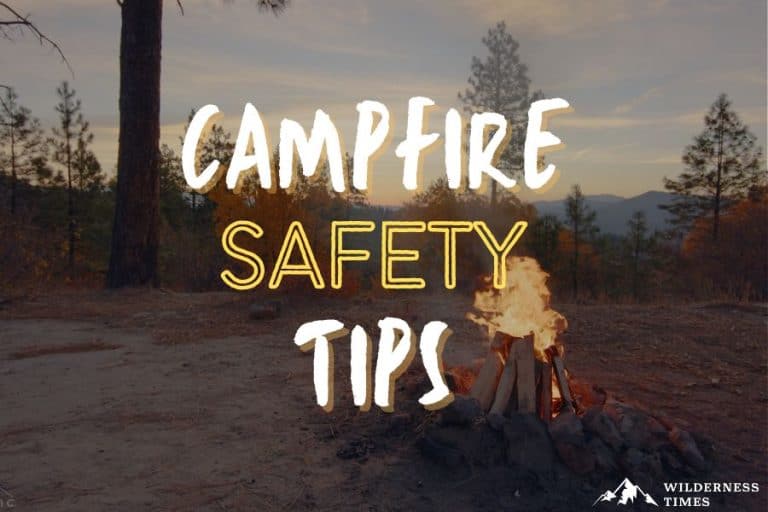Campfires are an essential part of every camping trip.
But they can easily turn into a disaster if you’re not careful.
However, there’s nothing you need to worry about as long as you know what to do.
And in this article, we’ll do exactly that.
Here’s everything you nee to know about campfire safety.
7 Critical Campfire Safety Tips
Let’s start with a couple of things you should always be doing, regardless of the location, size of the campfire, or any other factor.
Check for Fire Restrictions
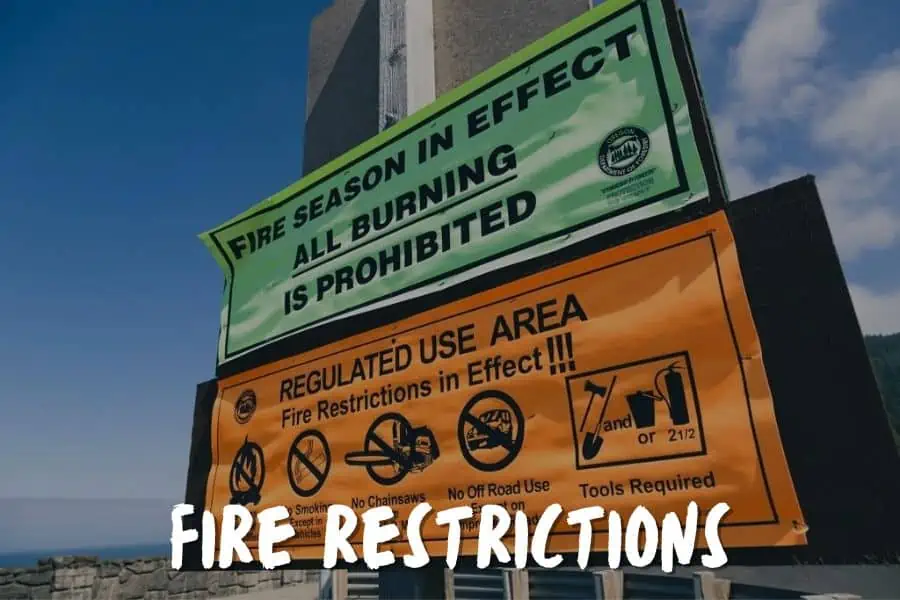
First things first – are there any fire restrictions in place?
Making a campfire while a fire ban is in place isn’t just against the law, but also very dangerous.
Those restrictions are in place for a good reason! Depending on the area, fire season can last for several months at a time.
In the last few years, due to climate change, fire bans have been in effect for up to eight months in certain areas of the country (places like Arizona, Utah, Nevada, California, etc.).
But keep in mind that fire restrictions can be in place even outside of the fire season, due to the weather.
This is something you should be checking on a day-to-day basis.
To do that, you can check with the agency that manages the land you’re camping on.
There are five levels of wildfire danger warnings, each indicating how risky outdoor burning is at a specific moment.
Also Read: Camping Without Fire – The Best Campfire Alternatives
Clear Debris Nearby
Before you start making a campfire, give the area a quick sweep. By this, I mean to remove any debris around, including dead leaves, twigs, and branches.
You don’t want ANY natural compound that catches on fire to be anywhere nearby.
You should also choose a spot that’s not covered in grass.
Most of the time you’ll be using an existing fire ring unless you are dispersed camping in a truly remote area.
Don’t Leave Fire Unattended
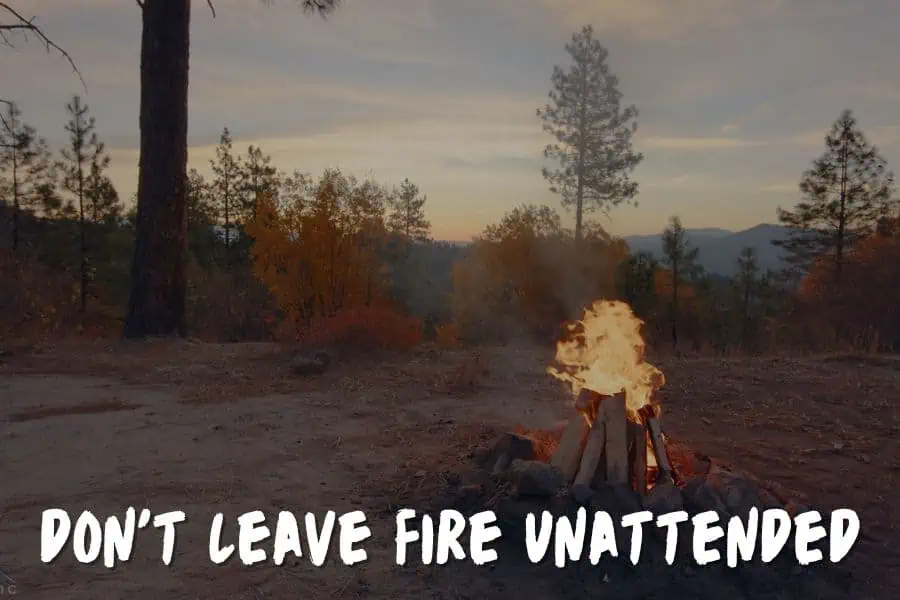
You might be tempted to go for a short hike or have a quick nap while the fire is still burning.
But I strongly advise you to avoid leaving a fire unattended, even if it’s smoldering.
The wind can be very unpredictive, and it only takes a single spark to create a wildfire.
In short, ensure that there’s always at least one adult in charge of keeping an eye on the fire.
If you’re leaving a campsite, even for a short period, do it only after you’ve completely extinguished it.
Always Keep Spare Water
Whenever you’re making a campfire, you need to make sure you have enough water to extinguish it afterward.
Sand and dirt are not effective options for putting out the flames completely.
Naturally, how much water you’ll need depends on the size of the fire.
But in most cases, you’ll need at least a bucket of water. I also like to keep my drinking water nearby – just in case.
Keep Your Camping Gear Away From The Fire
A big portion of your camping gear, such as sleeping bags, pads, and tents, are made of highly flammable materials.
A single spark can catch your stuff on fire, and it will burn down before you know which way is up.
Just to be safe, you should always keep your camping gear at least 15 feet away from the fire.
Pay Extra Attention to Camping Stoves
If you opt for a camping stove instead of a campfire, you’re still not out of danger when it comes to fire.
True, the risk of your stove starting a fire is not as big. But since it’s possible, you should always pay extra attention to your stove while its in use.
This is especially true for alcohol stoves. Not only do they produce hot, invisible flames, but many models can spill the alcohol if tipped over.
But any stove generally can be a fire hazard when not used carefully.
So just because you might not see big, red flames, that doesn’t mean that a stove is a much safer option.
Avoid Burning on Dry, Windy Days
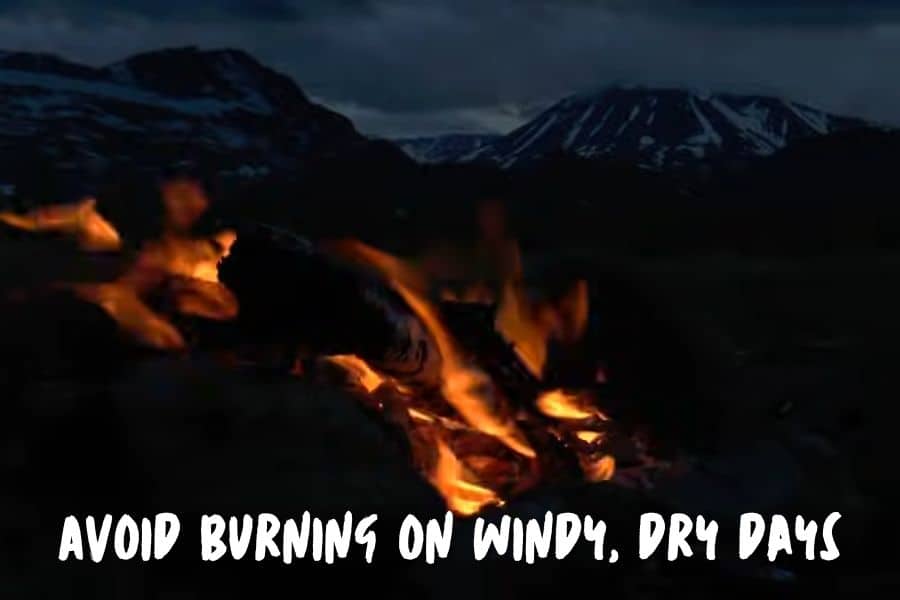
If the wind is blowing over 5 miles per hour, then it’s best to avoid making fire at all.
I know, the weather can be quite unpredictable sometimes.
One minute it is calm, and the next a breeze picks up.
If the wind picks up after you started your campfire, it’s best to put out the fire right away.
How to Safely Pick a Campfire Spot
You can’t – well, you shouldn’t – set up a campfire just anywhere.
In this section, we’ll cover things you need to keep in mind when picking a spot.
Find a Place With Little or No Grass
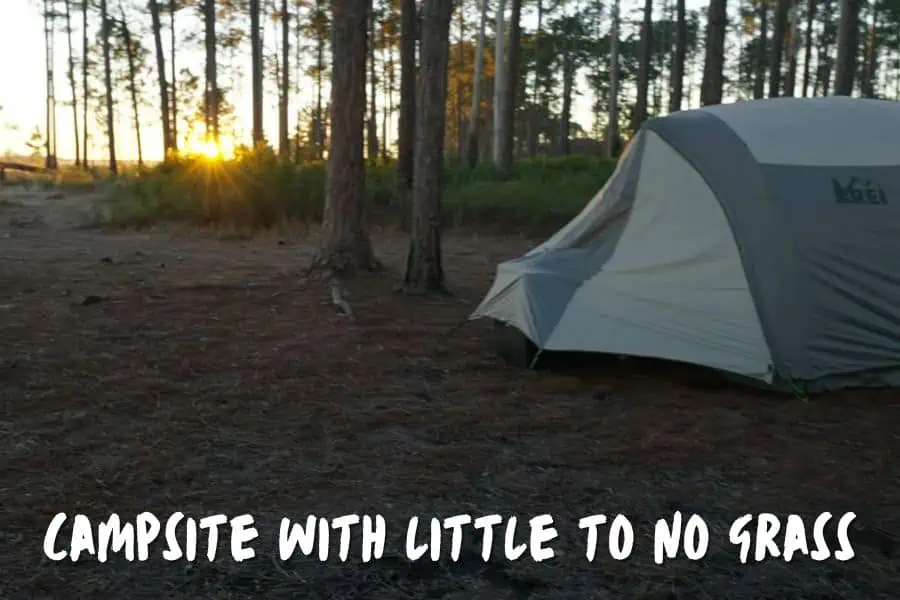
Like I already said, you don’t want to set up a campfire on lush grass, as it will scorch it down.
That, of course, doesn’t mean you should trample or remove it – instead, find a place with little or no grass to set up a campfire on.
That same spot should also be as open as possible, without any shrubs, trees, or overhanging branches in the near vicinity.
Even if the flames don’t go all the way up to the overhanging tree limb, they can still burn enough to start a wildfire.
Of course, the trees and bushes can serve as a great wind break, as long as they’re at least 5 to 10 feet away from the fire.
Use Existing Fire Rings
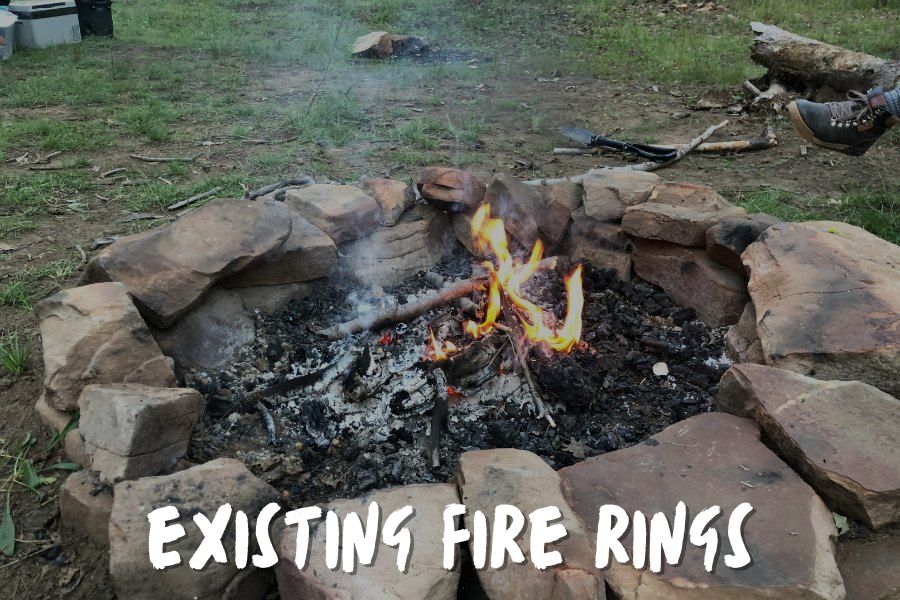
If there are any existing fire rings nearby, they’re your best spot for setting up a campfire.
You’ll find them at pretty much any established campsite, and even some dispersed areas as well.
Using a pre-existing fire ring helps reduce the human impact on an area, and it’s in accordance with Leve No Trace principles.
Hopefully, the campers that used the fire ring before you have packed up their mess, but if not, make sure to clear the ring before building your fire.
Don’t Build at the Base of Hills
If possible, avoid building a fire at the base of a hill.
Why? Well, the fire travels uphill rather fast. Hot gases inside the flame are much hotter than the air surrounding it.
So naturally, the flames move upwards, where there’s less air pressure. Plus, as it travels uphill, there’s less space between the flames and unburnt fuel (trees, bushes).
A flat surface would be ideal for building a fire, but if the terrain is sloped, then choose a high spot instead.
Beware of Duff
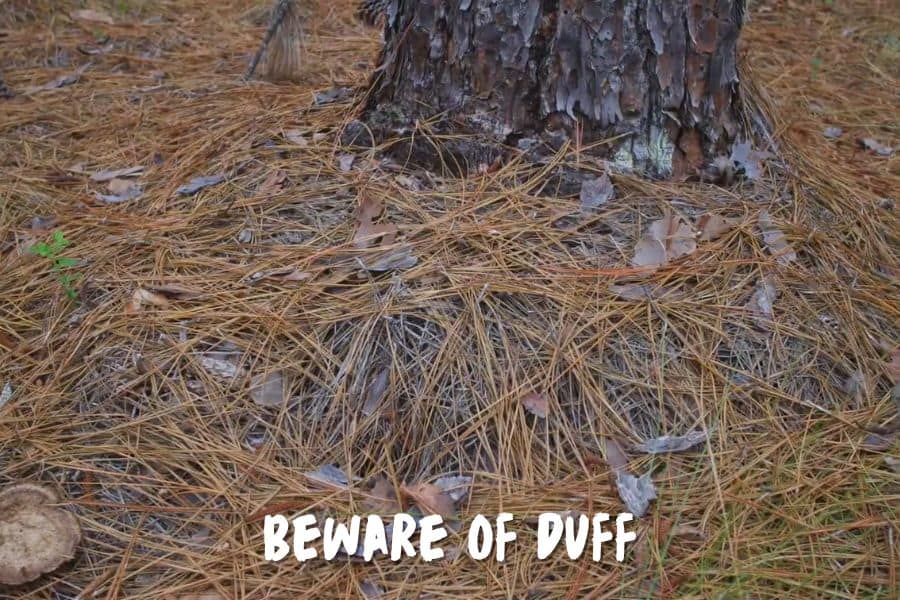
So, duff is a layer of decomposing organic debris covering the ground, usually sandwiched between the leaf litter and bare soil.
Duff looks pretty much like dirt, but it isn’t. The main difference is that duff burns.
You see, there’s a gas buildup inside caused by decaying matter.
When you combine the right level of moisture with heat increase, there’s a great risk of smoldering combustion.
Now, the problem with duff is that it can smolder for hours – even days after that.
And not just that, but it can go unnoticed until the leaf litter on top of it catches on fire.
So not only does it slowly kill the surroundings, but duff can burst into flames and cause wildfire as well.
How to Prepare a Campfire Pit Safely
Now that you’ve chosen a spot for making a campfire, let’s see what you need to do to prepare the fire pit.
Clear An Area at Least 10 feet (3 meters) Around The Pit
As we’ve already established, the area around the pit should be clear of anything that could potentially catch on fire.
So any dry grass, leaves, logs, branches, pine needles, and duff has to go. But the same also goes for damp debris, as that can also be a potential fire hazard.
The easiest way to clear the area is to use a shovel. Now, we’re not doing any digging just yet, simply removing the top layer of debris.
Ideally, you want to clear at least 10 feet around the spot you plan on setting up a campfire pit on.
Dig Out a Bowl-Shaped Indentation About 5 inches (13 cm) deep
Okay, this is where we put the shovel to work. In the middle of that cleared area, dig a bowl-shaped indentation that’s about 5 inches deep.
We do this so that the ground contains the coals and protects them from the breeze.
Now, how wide should the fire bowl be? Well, that depends on the size of the fire you want to build.
But in most cases, a one-foot diameter is more than enough for most purposes.
If any rocks are lying around, you can use them to create a diameter ring around the indentation.
You want the ring to be somewhat larger – two feet in diameter would do. That’s more than enough for a medium-sized campfire.
When building a ring, choose rocks that are about the size of your fist or larger.
Place them side by side so that there’s no gap between them, as that could allow the flames to escape.
Only dry rocks will work for this. Don’t take rocks out of the water source. If they’re porous, water will remain inside them.
But when you add heat into the equations, the water and air inside will expand and could cause the rock to explode in pieces.
You should also avoid limestone, pumice, shale, and conglomerates to create a fire ring, as these stones are layered and porous, so they can also shatter when heated.
Build a Fire Inside the Containment Ring
Finally, it’s time to build fire.
Logs are the main source of fuel, but you’ll need more than that to start the fire. You’ll need three types of wood:
- Tinder
- Kindling
- Fuelwood
Tinder is what you use to start the fire. It can be dry leaves, small twigs, or dry grass.
Tinder lights up fast, but also burns at the same speed. That’s why its main purpose is to ignite kindling.
Kindling is small pieces of wood, slightly larger than what you’d use for tinder.
This is the foundation of your fire, as it helps transfer the flames from tinder to larger logs.
Finally, you need proper fuelwood.
Now, here’s the thing. You should only use firewood that was cut within 50 miles of your current location.
That’s because firewood can be infested with invasive pests endemic to areas where they were grown.
Moving it more than 50 miles away risks potentially infesting healthy trees there as well.
If you’re collecting your own wood, you should be aware of the “Four D’s of Campfire Collection” which are part of the Leave No Trace principles. The four D’s mean:
- Dead
- Down
- Dinky
- Distant
In other words, only pick up wood that’s dead, on the ground, smaller than your wrist, and gathered from different locations around the campsite.
Read: How Much Firewood Do I Need For Camping? – And Where To Buy It
How to Build Your Campfire Safely
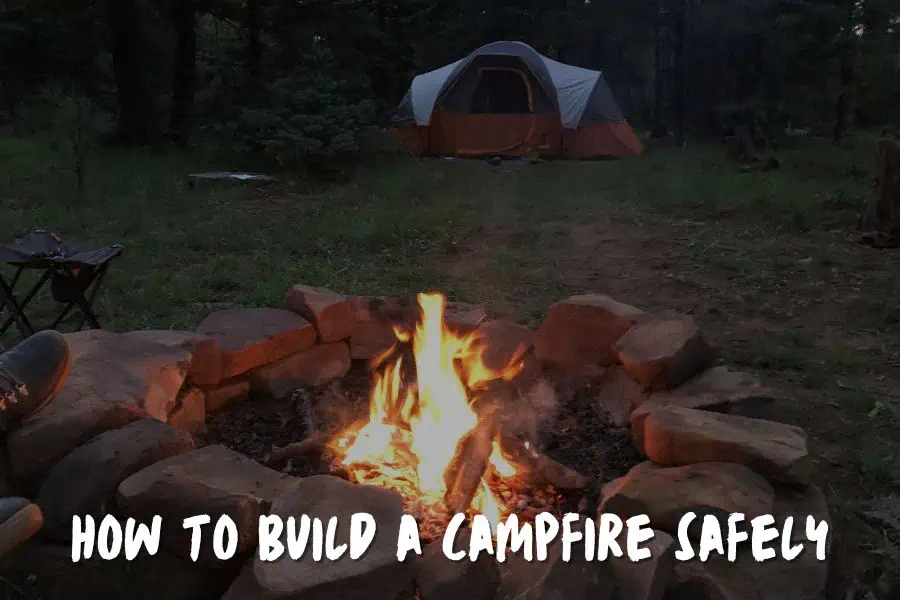
Alright, here’s the fun part – building your campfire.
As we already established, you’ll need to collect tinder, kindling, and firewood.
Ensure there’s enough fuel to last you as long as you need the campfire to keep going.
Generally, you’ll need four to five large logs for about two hours of burn time, but it depends.
One thing is that you don’t want to put them all at the same time. Instead, you add more as previously added log burns down to keep the fire consistent.
While your fire is burning, keep the rest of your logs at least 10 feet away from the fire so there’s no chance of an airborne spark setting them on fire.
There are many ways you can build a fire. Arguably the simplest is to make a teepee.
Layer the tinder and build a teepee around it with kindling. After you set it on fire, you slowly add fuelwood to build up the flames.
Other popular methods are log cabin and pyramid, and they both start by lighting the tinder and kindling before the flames spread to fuelwood.
While teepee is better for cooking, log cabin and pyramid are more lasting methods.
How to Maintain Your Campfire
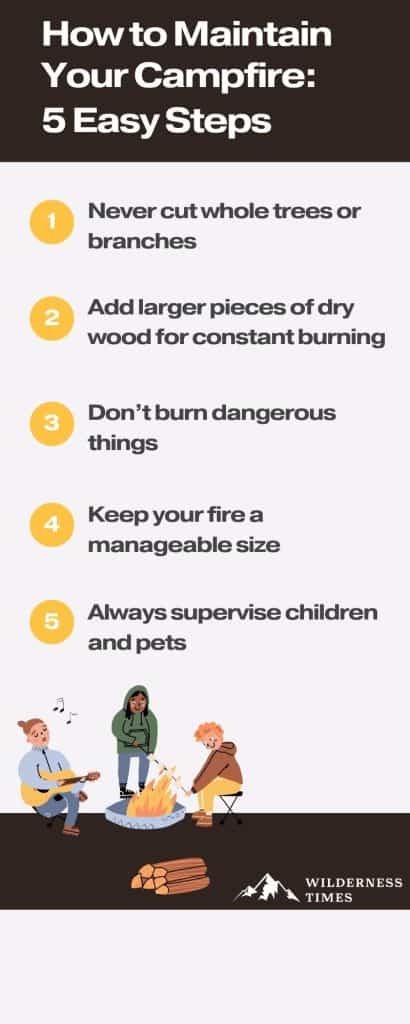
So, your fire is going nicely, but you need to make sure it also lasts long enough.
This is especially important if you’re cooking something that requires a few hours of simmering.
Never Cut Whole Trees or Branches
As you already know, you should never cut whole trees or branches. First, that’s one of the main Leave No Trace principles.
But not just that, green wood won’t burn. It takes roughly about six to nine months for a tree to “season” after it’s being cut down.
The process of seasoning is allowing moisture inside the tree slowly dissipate from it.
If you were to light green wood on fire, you’d have a very hard time starting it up in the first place.
And even when you finally do get it going, it’s near impossible to keep it burning steadily. Not just that, but it emits horrible smoke.
Add Larger Pieces of Dry Wood for Constant Burning
When starting a fire, you need small pieces of wood that can easily catch on fire.
But once the fire is ignited, you need larger pieces of wood to keep it burning at a constant pace.
Now, I’m not saying you should add logs that barely fit inside the fire. If a wood log is more than 5 inches in diameter, you must split it before adding it to the fire.
However, you should keep in mind that not all wood burns the same. The denser it is, the longer it burns. It makes sense – there’s more material inside of the log.
Furthermore, hardwood burns slower and better than softwood. And among them, hickory, oak, and ash burn the longest.
Remember, don’t add all logs at once. You should only add one log per hour once the fire is nice and steady as you want it to be.
You’ll want your burning logs to turn halfway into embers before you add more.
Don’t Burn Dangerous Things
I totally get it – throwing various things like trash or leftover food into the fire may seem like a good way to get rid of it. But it can be really dangerous.
Throwing food scraps into the fire doesn’t seem that bad, right? After all, that’s organic matter.
Well, it’s still dangerous. Food waste will give off a smell when it burns, which can attract wildlife.
Those animals will come to the campsite in search of food, but what they find there is not something they should eat.
Plus, having wildlife visiting your camp isn’t very safe either, given that wild animals can be unpredictive, especially around food.
Burning trash, including plastic is also something to avoid. First, it smells horrible and you don’t want to breathe that in either.
Many plastic polymers release carcinogen chemicals into the air when heated.
What’s more, everything they leave on the ground is just as dangerous.
I’m sure you’re aware that plastic takes a very long time to decompose, meaning it stays in the soil.
Instead of burning your waste, pack it up and dispose of it in an appropriate place for that.
Keep Your Fire a Manageable Size
Look, you don’t need a huge bonfire when you’re out camping. Even if you’re only using a campfire for warmth, you don’t need it to be huge.
Even if you’re camping with a large group, you don’t need a campfire larger than three feet in diameter.
That’s more than enough to warm up the entire group and fire any bigger than that would be difficult to contain.
Always Supervise Children and Pets
If you’re camping with kids or pets, make sure they’re never alone when around the campfire.
Even if your child has seen you handle the fire numerous times before.
In case of emergency, young children aren’t equipped with enough knowledge and experience to handle such situations.
I wouldn’t expect your dog to be able to handle an emergency situation either…
Campfire Cooking Safety Tips
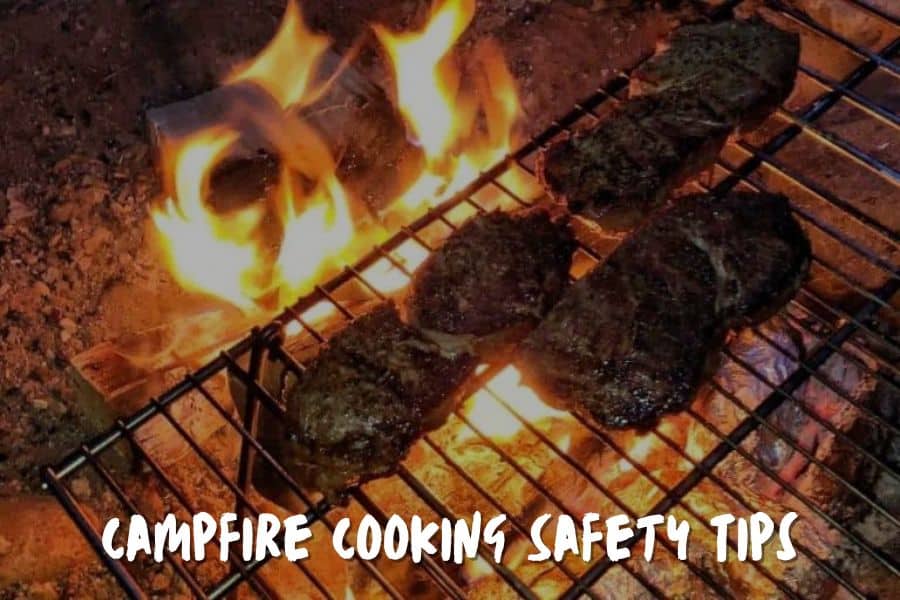
If you’re already building a campfire, it would be a waste not to use it to make a delicious meal.
No matter how quick and practical stoves are, there’s something so enjoyable about eating food straight from the campfire.
However, there are some things to keep in mind when cooking on an open fire:
First, you don’t want to place your pot directly onto the flames. The blue tip of the flame is extremely hot, reaching over 2000 degrees.
If you were to place food over that, it would get scorched practically instantly.
What’s more, your cookware might not be able to handle such high heat. Aluminum, for instance, melts at just 1220 degrees.
Instead of putting your food directly on the hot flames, you should use some kind of cooking surface, like a grate or Dutch oven stand.
If you don’t have one, you can move hot coals on one side of the pit. Place your cookware once the coals turn white.
Keep in mind that some vapor or oil can come out of the pot into the flames, causing flare-ups.
That’s nothing unusual when cooking over an open flame, and you can easily calm the fire down by spraying a bit of water onto it.
Also See: How to Cook Over a Fire (Pro Campfire Cooking Tips)
FAQs
What are the 3 A’s of fire safety?
In the case of fire, remember three A’s – Activate, Assist, Attempt.
Activate means activating an alarm and calling 911.
Assist means helping anyone in immediate danger.
And finally, ONLY after you complete the first steps, you may Attempt to extinguish the fire.
What should you put in the bottom of a fire pit?
You want to put dirt, gravel, or sand at the bottom of a fire pit. These materials are non-combustible and will prevent the flames from spreading around.
Plus, you’ll find at least one of them mixed in with the soil in an area you’re camping in.
What is the best material to burn in a fire pit?
Harwood, such as oak, beech, and ash are arguably the best options for burning in a fire pit.
These types of wood burn long and efficiently, creating nice flames without much smoke.
What are the basic steps to take during a fire emergency?
In case of a fire emergency, you must try to extinguish the flames with water.
You should always have enough water readily available whenever you’re making a campfire.
However, if the fire keeps spreading, call 911 and keep all of your group members safe.
Do and don’ts during a fire emergency?
Do use a lot of water to try and put out the fire. But if there isn’t enough water, you can throw the dirt onto the flames.
However, DO NOT throw duff, as duff is highly combustible and will create an even bigger fire.
To Sum Things Up
As you can see, there are quite a few steps you need to take when making a campfire.
From choosing a proper spot to preparing a campfire ring, these steps ensure that you can make a campfire without any safety issues.
While they might seem tedious at first, these steps will come naturally to you after a first try.
Next up: Camping Etiquette


